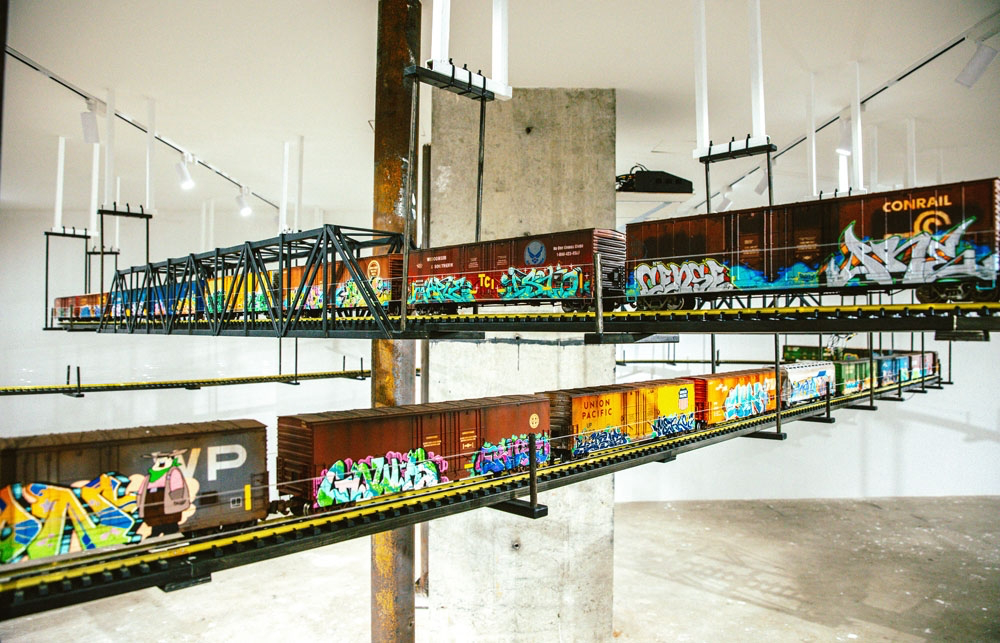
Tim Conlon, widely known as The Freight Painter, has left an indelible mark on the world of contemporary art through his masterful depictions of freight trains adorned with graffiti.
His hyperrealistic style, combined with his deep-rooted passion for urban art, has positioned him as one of the most respected artists in the graffiti and street art movement.
Beyond being a painter, muralist, and sculptor, Conlon is a documentarian of an often-overlooked subculture—freight train graffiti.
His ability to translate the grit and history of train yards onto canvas and large-scale installations has garnered him widespread recognition in both the graffiti community and the fine art world.
His work has been displayed in prestigious museums and galleries, including the Smithsonian National Portrait Gallery, the Los Angeles Museum of Contemporary Art, and the Corcoran Museum. Conlon has also been a key figure in the globally celebrated BEYOND THE STREETS exhibitions, which showcase the evolution and impact of graffiti and street art.
His inclusion in Sotheby’s inaugural Hip Hop auction further cemented his status as an influential artist bridging the gap between graffiti, fine art, and urban culture.
However, Tim Conlon’s impact extends beyond the gallery walls. His involvement in the Rolling Like Thunder documentary on SHOWTIME highlights his dedication to preserving and celebrating the history of freight train graffiti.
This deep-rooted connection to the culture, combined with his unparalleled skill in photorealism, has made him a pivotal figure in the street art movement. His work resonates not only with art collectors but also with graffiti aficionados who recognize his role in bringing the underground world of freight train graffiti to a global stage.
Early Life and Artistic Beginnings
Tim Conlon’s journey into the world of graffiti and contemporary art began like many artists—by immersing himself in the streets. Born and raised in the United States, Conlon developed an early fascination with graffiti, particularly the raw, unfiltered expression it provided artists working outside traditional art institutions.
While mainstream art was often confined to galleries and museums, graffiti was a democratic art form, accessible to anyone with a can of spray paint and a vision.
As he explored urban landscapes, Conlon became particularly drawn to freight trains as a canvas. Unlike static city walls that could be painted over or demolished, freight trains carried artwork across vast distances, turning graffiti into a traveling exhibition.
This nomadic nature of train graffiti resonated with him, fueling his passion to document and recreate these moving murals in his own artistic style.
His early works captured the essence of train yards—the rust, the layers of paint, and the remnants of past graffiti artists who had left their marks before him.
This commitment to authenticity would later become a defining aspect of his career, setting him apart from other contemporary artists who simply adopted graffiti aesthetics without immersing themselves in the culture.
Mastering Photorealism and Large-Scale Works
One of the most striking aspects of Tim Conlon’s work is his ability to achieve photorealistic detail in his paintings and murals. His depictions of freight trains are so lifelike that viewers often feel as if they are standing in front of an actual railcar, complete with the texture of peeling paint, rust stains, and weathered metal. This attention to detail showcases not only his technical skill but also his deep appreciation for the history embedded in these trains.
Conlon’s large-scale works often feature full-scale replicas of freight train cars covered in graffiti, bringing the authenticity of rail yard graffiti into the controlled environment of galleries and museums.
These installations serve as both an artistic tribute and a historical archive, preserving a fleeting art form that is often erased or repainted over time.
In addition to paintings, Conlon has explored sculpture, creating three-dimensional works that replicate train cars with stunning precision. These pieces bridge the gap between traditional sculpture and street art, demonstrating his ability to innovate within multiple mediums while staying true to his roots.
Recognition in Galleries, Museums, and Auctions
Tim Conlon’s work has not only resonated with graffiti enthusiasts but has also gained recognition in the contemporary art world. His paintings, murals, and sculptures have been featured in some of the most prestigious art institutions in the United States and beyond.
One of the most notable milestones in his career was his participation in BEYOND THE STREETS, a groundbreaking exhibition that has toured multiple cities, including Los Angeles, New York, London, and Shanghai. Curated by Roger Gastman, the exhibit showcases the evolution of street art and graffiti, featuring work from some of the most influential artists in the movement. Conlon’s inclusion in these exhibitions solidified his reputation as a leading figure in contemporary graffiti-inspired art.
In addition to museum and gallery exhibitions, Conlon’s work was also featured in Sotheby’s inaugural Hip Hop auction. This event marked a significant moment in art history, as it recognized graffiti and street art as integral components of hip-hop culture. Conlon’s presence in the auction highlighted the growing appreciation for graffiti as a legitimate art form within high-end art markets.
Documenting Freight Train Graffiti: Rolling Like Thunder
Tim Conlon’s contributions to graffiti culture go beyond his own artwork. He played a crucial role in producing Rolling Like Thunder, a SHOWTIME documentary that delves into the history and significance of freight train graffiti. The film explores the lives of graffiti artists who have dedicated themselves to painting freight trains, often at great personal risk, to keep the tradition alive.
Rolling Like Thunder sheds light on the underground network of artists who view train graffiti as more than just an act of rebellion—it is a means of storytelling, legacy-building, and artistic expression that transcends geographical boundaries. The documentary serves as an important historical record, ensuring that the contributions of freight train graffiti artists are recognized and preserved for future generations.
The Influence of Conlon’s Work on Graffiti and Contemporary Art
Tim Conlon’s work occupies a unique space between graffiti, fine art, and documentary storytelling. His ability to capture the raw energy of train yard graffiti while presenting it in a refined, gallery-worthy format has inspired both emerging street artists and seasoned collectors. His paintings offer a bridge between two worlds—bringing graffiti into fine art spaces without compromising its authenticity.
Many contemporary graffiti artists have drawn inspiration from Conlon’s approach, recognizing the power of merging photorealistic techniques with the grit of urban landscapes. His dedication to freight train graffiti has also sparked renewed interest in the culture, encouraging younger artists to document and celebrate this often-overlooked aspect of graffiti history.
Challenges and Controversies in the Graffiti Art Scene
Despite his success, Conlon’s work exists within the broader debate surrounding graffiti as an art form. While street art has become increasingly accepted in mainstream culture, graffiti—especially illegal graffiti—continues to be criminalized. Many graffiti artists struggle with the paradox of having their work celebrated in galleries while still facing legal repercussions for creating it in public spaces.
Conlon’s work challenges these boundaries by emphasizing the artistry behind graffiti without romanticizing vandalism. His large-scale recreations of freight train graffiti provide a legal platform for showcasing an art form that is often erased or dismissed. In doing so, he sparks conversations about the value of graffiti in contemporary society and the need for greater recognition of street artists as legitimate contributors to the art world.
Tim Conlon’s Legacy and Future Projects
As Tim Conlon continues to push the boundaries of graffiti-inspired art, his legacy grows stronger. His ability to blend photorealistic painting, sculpture, and large-scale installations with a deep respect for graffiti culture ensures that his work will remain relevant for years to come.
Looking ahead, Conlon is expected to continue his involvement in major exhibitions, expand his body of work, and further explore the intersection of graffiti and fine art. With street art and graffiti gaining more recognition worldwide, artists like Conlon are at the forefront of ensuring that the movement’s history and significance are preserved.
No comments yet.








